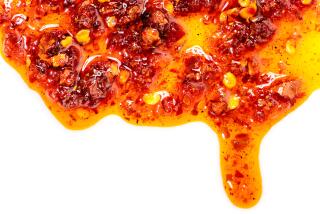Better Living Through Kimchi : S. Korea Sets Out to ‘Globalize’ Appeal of Its Revered Vegetable Dish
- Share via
SEOUL — When the winds begin to whip and the autumn leaves wither, Shin Im Soon knows it is time to prepare the winter’s supply of kimchi--the spicy fermented vegetables that symbolize Korean cuisine.
“We have lived with kimchi for centuries. It has become part of our bodies,” says the ruddy-cheeked woman, as she cleans and salts piles of cabbage, radishes and green onions in her twice-yearly ritual. “If you don’t have it, your digestion process slows and your mouth feels out-of-sorts.”
Now younger Koreans are losing their taste--and technique--for this staple side dish. And South Korea is trying to export its elixir of health to the world in a move to make kimchi as familiar to foreigners as sushi.
The government has declared that it will try to “globalize” kimchi, and has kicked off a $1.5-million research program to scientifically establish its healthful benefits.
The question is: Can foreigners learn to love a pungent dish of garlic, chili peppers, fermented fish and vegetables--an acidic concoction of chemical processes that can temperamentally skid from searing to sour depending on temperature, salt content and sitting time?
Steve Smithans, an Australia-based technical-services manager now visiting Seoul, got his first taste of kimchi last week.
“I wouldn’t put it out at my barbecues,” he said.
His friend chimed in: “It’s radical!”
Enter men such as Hwang Jong Hyun, the ace kimchi researcher with the Doosan Training & Technical Center.
Ever since Doosan, a major food distributor, was named the official kimchi supplier for the 1988 Seoul Olympics, Hwang has wrestled with vexing kimchi challenges. How to modify the fermentation process to prolong its shelf life, for instance. Even tougher was figuring out how to package the volatile mix to prevent its expanding carbon dioxide from bursting through the container.
But nothing has topped his latest task: to follow government orders to develop a kimchi “as popular as American pizza around the world.”
“If we put our beloved kimchi in front of our African friends, they won’t touch it,” he said. “But if we have information about what is the most popular vegetable in Africa, we can use that to develop kimchi for Africa. Instead of giving sermons to globalize kimchi, the government should give us information.”
Nevertheless, Hwang has gamely tackled the task. Among the 200 different kinds of kimchi, he has strategically selected “white” kimchi as the surest bet for foreign palates.
The mild cabbage dish steeped in salt, ginger and garlic, he believes, would sell as a kind of South Korean sauerkraut.
Hwang also hopes to prove--and publicize--the dish’s healthful properties long taken for granted by centuries of Koreans.
Kimchi, he said, is believed to provide vitamin E and dietary fiber to help stabilize the digestive organs and to prevent obesity.
With or without the research, South Korea’s kimchi exports are growing each year.
*
During the first six months of 1995, total exports of kimchi worth $26 million marked a 32.1% increase over the same period the previous year; in 1992, exports stood at $16.5 million for the entire year.
Doosan expects its share of exports to grow 20% to $4 million next year. The firm has given up on the U.S. market--competition from domestic kimchi makers is too stiff, Hwang said--and ships 83% of its supply to Japan. Hong Kong, England and New Zealand are new markets.
For Doosan and others, exports may be the best hope for growth.
FOR PIC SLUGGED KIMCHI
More to Read
Sign up for Essential California
The most important California stories and recommendations in your inbox every morning.
You may occasionally receive promotional content from the Los Angeles Times.











